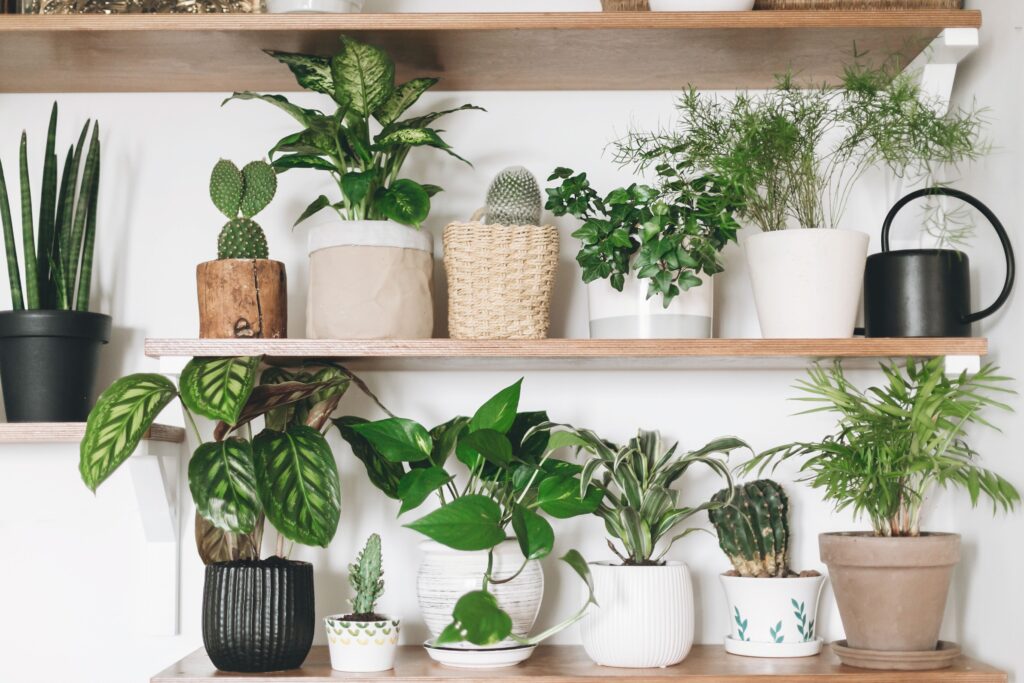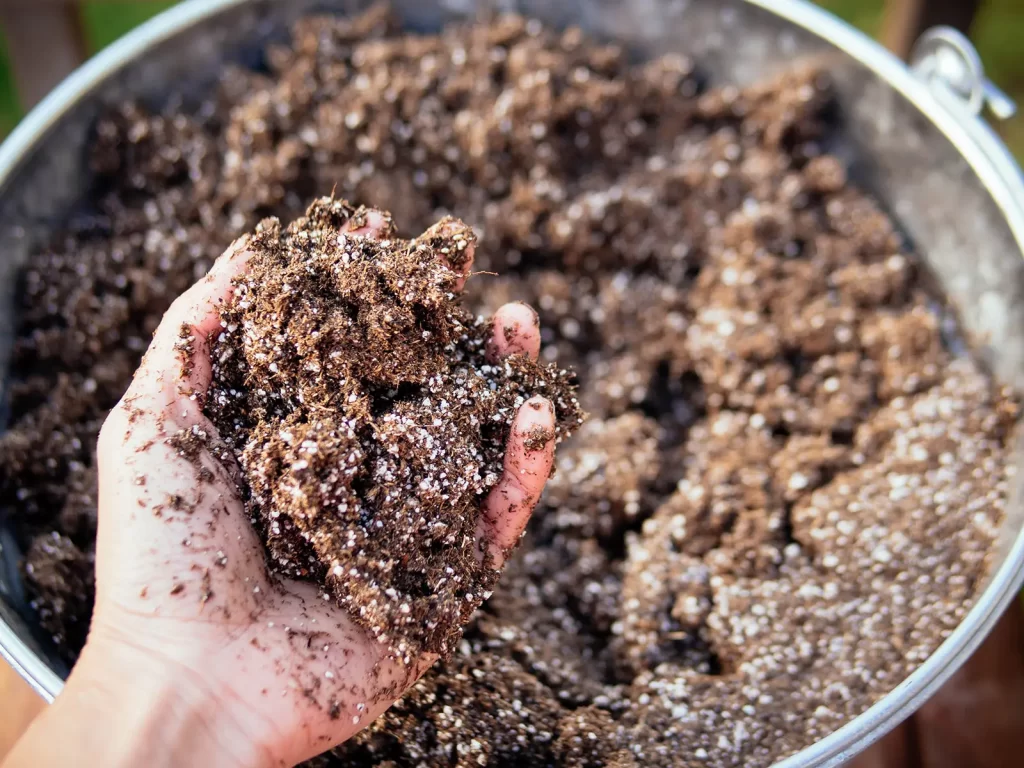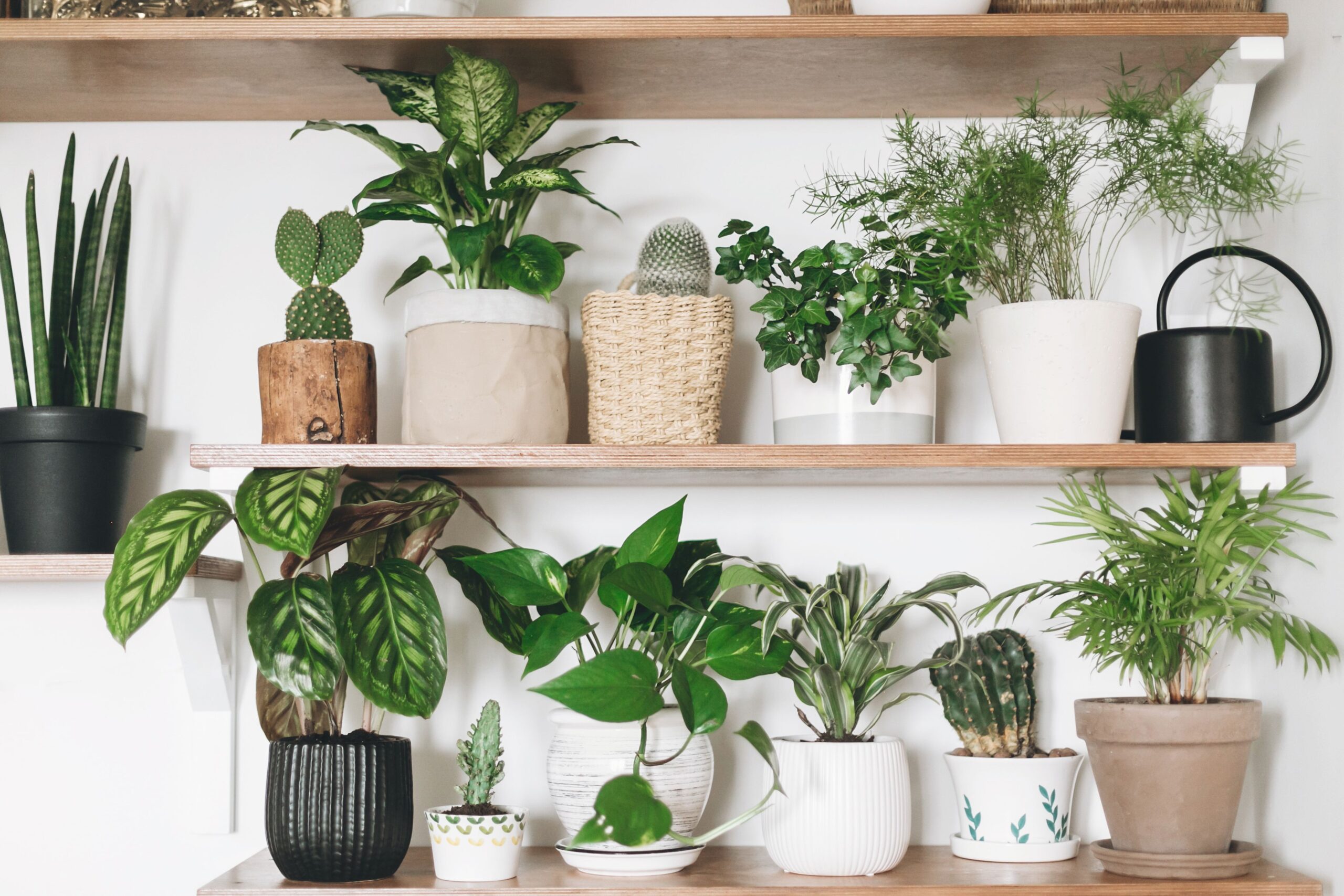Provide a solid foundation for healthy plants with this houseplant soil recipe. By using 6 different sustainable and organic ingredients, your indoor plants will have everything they need to grow big and strong, becoming your home’s joy hub!

The foundation of any healthy plant, soil ensures that our plants can support themselves, get enough water, and all the nutrients they need to produce the greenest leaves and the biggest flowers. If you want healthy houseplants, you need a good potting soil to get you started.
Today’s houseplant soil recipe comes from my book, Garden Alchemy. If you want to take a deep dive on soil and other organic gardening recipes and methods, this book is for you! It has over 80 recipes inside for indoor and outdoor gardening, all using organic methods.

CAN I USE ANY SOIL FOR HOUSEPLANTS?
Compared to the plants in our garden, houseplants are at a disadvantage. By living in pots, they do not have the opportunity to gather nutrients from the earth and the extra moisture held within deep soil. That’s why it’s especially important we give them the best chance possible by planting them in high-quality potting soil.
Have you ever noticed how often you need to water your houseplants? They tend to dry out quickly and require a potting mix that can actually retain moisture better to keep them hydrated. Indoor plant roots also need air circulation and drainage. So an indoor soil mix should balance the need to hold onto moisture, create air pockets, and allow for the excess water to drain freely through the drainage holes in your pot. In summary, the three things you need in a good potting soil structure are materials for:
- water retention
- aeration
- drainage
Other key factors when it comes to indoor soil are not about the soil at all, but what we put the soil in, and what we put in it. We must ensure plants have enough room to grow and have the right nutrients.
- To give them enough room to grow, they will a large enough pot.
- Add fertilizer to your houseplants to give them the right nutrients.

CAN I USE OUTDOOR SOIL FOR INDOOR PLANTS?
With how much I talk about how outdoor soil is essential for plant health, you may think that it’s right for houseplants as well. But bringing in soil that is already full of nutrients, it’s also full of microorganisms and soil wildlife (like worms and bugs).
By bringing this soil inside you’re also bringing in these organisms….BUT not their predators. Without the complete ecosystem that exists outdoors, the organism population can quickly get out of hand in a bad way.
While I love critters in the garden, it’s best to keep them there! Otherwise, you may get pests like fungus gnats inside the house. Instead, use a sterile houseplant soil recipe and add nutrients to it through an indoor plant fertilizer.
My indoor plants absolutely thrive with this houseplant soil recipe, getting all the nutrients and moisture they need to grow and grow. To begin, let’s break down the ingredients and how to get your soil ready for potting.

Get Your Compost Ready
MAKE YOUR COMPOST
The most important ingredient of this houseplant soil recipe is the compost, so you need to make sure it is done right! Compost is made up of broken-down organic matter that is rich in microorganisms and adds life to soil. It holds moisture and allows nutrients to be available to plants; however, quality varies greatly on the inputs and composting methods.
Both urban and farm compost can be devoid of proper nutrients and contain undesirable materials such as pesticides, herbicides, and plastics. Use properly balanced homemade compost or purchase top-quality commercial compost from a trusted source.

STERILIZE YOUR COMPOST
Your compost is nearly ready. However, it is very important to sterilize the compost before you bring it into the house and keep critters, fungi, and bacteria at bay. Properly finished and screened compost is the cornerstone of building many potting soils. Sterilizing it will help to kill of harmful bacteria (while keeping the good bacteria), keep away pests, and prevent disease.
I like to prepare compost for soil for houseplants by baking moist compost in the sun. Or, you can use an oven and let it run for at least thirty minutes at 180 degrees F (82 degrees C). Warning, this method does get a little stinky!
Alternatively, you can purchase a sterilized compost. Store any leftover compost in an airtight container for future indoor and seed-starting potting mixes.
With the exception of compost, the rest of the soil ingredients in this recipe do not have active biology so they can be added as they are purchased.
Best Houseplant Soil Amendments
You’ve got your number one ingredient, compost. So, what else do you need? In order to make the best soil for houseplants, you must incorporate the right ingredients. Together, these ingredients make up my houseplant soil recipe, but if your current soil is not performing well, they also make for great houseplant soil amendments.

SPHAGNUM PEAT MOSS ALTERNATIVE
Sphagnum peat moss is a natural occurring, moisture-retaining material that is free of plant pathogens, weed seeds, mineral salts, or heavy metals. However, harvesting sphagnum peat moss comes with many sustainability issues that need to be considered.
The peat moss comes from bogs, which are excellent at absorbing and storing carbon to reduce climate change. When they are harvested, this carbon is released.
In addition, peat bogs are also home to many wildlife and plant species. Unfortunately, many countries have over-harvested peat moss and even sustainable harvesting practices still take years to repair while releasing a ton of carbon.
Beyond the sustainability issues, sphagnum peat moss is also very acidic and difficult to re-hydrate. The acidic pH, re-hydration issue, and sustainability concerns are strong enough reasons to go with a peat alternative. Coconut coir or woody materials such as sawdust, composted bark, or wood fiber work as a replacement for this recipe.
WORM CASTINGS
Worm castings are worm-digested organic material AKA vermicompost. They are nutrient-rich and contain many microbes. Worm castings retain soil nutrients and moisture allowing both to be more available for plant uptake. Worms filter out heavy metals and contaminants from the soil, which makes castings an excellent fertilizer for organic gardens. I purchase packaged worm castings rather than that those I make at home to ensure it doesn’t bring in bacteria, fungi, pests, or other organisms. I use my vermicompost to feed the outside plants instead.

PERLITE
Perlite is a naturally occurring volcanic glass that is highly porous and lightweight. When heated, it puffs up and looks like balls of Styrofoam. It is added to soil to increase drainage and aeration, keeping soil lightweight and free-flowing. It is a good option for a succulent/cactus mix, propagating root cuttings, and container gardening.
VERMICULITE
Vermiculite is a naturally occurring group of minerals that has a spongy texture when processed into pellets (chips). It absorbs and holds moisture and aerates the soil structure. Vermiculite has a neutral pH and it is often used in seed-starting mixes. Only horticultural grade vermiculite should be used for potting soils.
SAND
Sand is a fine granular rock that improves drainage when paired with organic materials. Too much sand in soil can affect the soil structure and decrease permeability. Look for horticultural or play sand as a potting mix ingredient, as beach sand can contain salt, glass, and plastic.

The Best Soil for Houseplants
Remember, this mix is for indoor tropical plants. Ensure that the ingredients you use are sterile to avoid introducing plant pests and diseases.
Houseplant Soil Recipe Your Plants Will Love
Packed with nutrients, these 6 ingredients make the perfect potting mix for your indoor plants.
Supplies
- 2 parts sterilized compost
- 2 parts peat moss alternative
- 1 part worm castings
- 1 part perlite
- 1 part vermiculite
- 1 part sand
Instructions
Mix your soil ingredients well. When potting, be sure to moisten your soil before planting your houseplants.
Water plants thoroughly and again whenever the soil has completely dried out.

